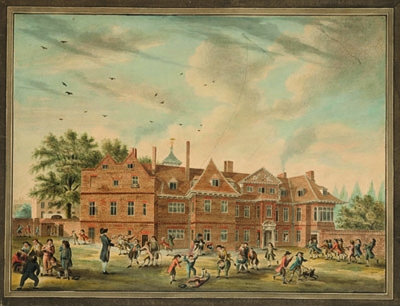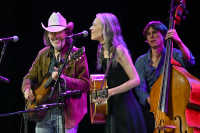‘Professor’ Bruce Lacey (born 1927) is one of those figures who has existed effectively on the periphery of the art world for more than half a century. Part licensed jester, part society’s conscience, Lacey operates best on the fringes, stirring things up, provoking thought and challenging preconceptions, a lightning conductor for comment and criticism. Before this exhibition, I associated him principally with the Kitchen Sink painters (John Bratby used to describe him as ‘a whizz’) and the type of idiosyncratic humour best exemplified by the Bonzo Dog Doo-Dah Band.
In fact, the ‘Prof’ appeared with The Alberts, a subversive neo-Edwardian jazz band and forerunners of the Bonzos, in a cabaret called An Evening of British Rubbish, much admired by the American comic Lenny Bruce, sending up what the performers saw as the pomposity of Empire, the Army and even the Union Jack itself. (A radical poster based on the flag, and designed by John Sewell for the show at the Comedy Theatre, forms part of a prologue of posters in Camden’s foyer.) It was satire with a mechanical frisson, for Lacey brought the new technologies of tape and film to The Alberts’ vaudeville act, and began to introduce robots as early as 1962, on the stage of Peter Cook’s Establishment Club.
Robots have ever after been associated with Lacey, who specialises in automata and humanoids, half-satiric and half-celebratory, and looking rather like some of Eduardo Paolozzi’s collages brought to three-dimensional realisation and mechanical life. The main ‘sculpture’ of Lacey’s with which I was already familiar was ‘The Womaniser’ (1966), now in the Tate but not purchased by that esteemed institution until 2001. This piece forms the centre of a dramatic tableau in Camden’s Gallery 1, featuring several of Lacey’s automata, though as all of them are ancient and incredibly fragile, only two are actually in motion. One is ‘Boy, Oh Boy, Am I Living!’ (1964), also in the Tate collection, which cranks itself up every few minutes to shake a leg with a loud clatter, and the other is ‘The Womaniser’. This monstrous many-handed reclining object feebly inflates and trembles, in parts, and actually does very little, which is, of course, part of its humour and pathos. Poor old thing, it can’t manage much these days. (Could it ever?)
There are other static robots such as ‘Old Money Bags’, ‘Superman’ and ‘The Politician’, a penny-in-the-slot operative with foghorn mouth and upraised hands, but the most notorious is ‘ROSA BOSOM’, or ‘Radio Operated Simulated Actress, Battery Or Standby Operated Mains’, from 1966. This luscious-lipped humanoid acted as Lacey’s best ‘man’ at his second marriage, and is evidently part of the family. In 1985 he entered her for Andrew Logan’s ‘Alternative Miss World’ competition, which she won, and there is much footage of her shuffling around kissing and being kissed. Unfortunately she is stationary in this exhibition (perhaps Bruce doesn’t trust her to behave when he’s not around), but she is clearly the life and soul of the party when on form. However, the kinetic element is sadly lacking from this show of somewhat stilled madness.
Lacey, the Grand Old Man of inspired happenings, has described his work as a form of personal psychotherapy, and in Gallery 2 this takes the form of objects (including a wall of capes and costumes) used in rituals to celebrate the Earth Goddess, together with rather diagrammatic related paintings in oil on sackcloth. He is quoted as saying: ‘I believe in real magic and that all things are connected in a spiritual telepathic way.’ In Gallery 3 is a whole wall of his 1950s Royal College Kitchen Sink paintings and a genetic installation devoted to his nine children and their two mothers. If you miss the London run, this exhibition, co-curated by artist Jeremy Deller and art historian David Mellor (who has written a scholarly exegetical history of Lacey’s exploits, published in paperback at £12.50), will travel on to the Exchange Gallery in Penzance in October. Is Lacey a latter-day English Dadaist or a cranky New Age shaman? You pays your money and you takes your choice…
Meanwhile at Gainsborough’s House is a very different kind of show: a collection of drawings and watercolours dating from 1700 to 1840 assembled by an individual living in East Anglia. Huon Mallalieu, an authority on English watercolours, has selected some 70 works from this extensive private collection and compiled a very useful catalogue (only £4.95) in order to illuminate Gainsborough’s period through the work of his contemporaries. Although the exhibition is weighted towards topography, shading into pure landscape, the subjects also diversify into genre, portraiture and architecture. There is enough variety in theme and in approach — provided by a wide range of practitioners, from the famous to the amateur — to satisfy the most demanding of gallery-goers.
In the main gallery, there is much to divert the attention, not least a couple of things by Thomas Jones (1742–1803), who produced some of the most luminous and informal paintings of walls in Naples ever seen. Here he is represented by a dark but atmospheric oil on paper study entitled ‘In the Colosseum’, and a light-filled blue-ish watercolour landscape inscribed ‘Tivoli’. Nearby is a strong ink and wash drawing by the Lancashire landowner and amateur painter, William Assheton, depicting rocks and rubble and trees and herbage, called ‘Roman Ruins by a Wall’. Elsewhere is a rather lovely little Rowlandson, ‘Venus Reclining in her Shell’, languorous rather than satiric, and an amazing portrait of a vast tree, ‘Elm at Helmingham, Suffolk’, by Isaac Johnson. Painted in watercolour in 1785, this huge filigree canopy of leafless branches celebrates a tree 68ft high, with a spread of 34 yards in diameter. There’s also a deliciously melancholy brown wash study of ruined arches by William Gilpin, ‘the High Priest of the Picturesque’, and a slight but enjoyable view of ‘Lambeth Palace from Parliament Stairs, Westminster’, by Wenceslaus Hollar, the boats and watermen in the foreground bringing real interest to the scene.
At the other end of this room is Turner trailing clouds of glory, with a lovely explosive sunrise off Margate, and William Sawrey Gilpin (the other’s nephew) offering a very modern-looking rendition of breaking waves. Next to Turner is a lucid Francis Towne watercolour of typically pronounced linearity and interlocking shapes, and a fine drawing of Bothwell Castle by his most talented pupil, John White Abbot. There’s a vibrant ‘Bridge with a Gleam of Sunlight’ by John Glover, a subtly coloured William Turner of Oxford, lovely Sandbys and a dreamy John Webber prospect of Derbyshire. Gainsborough himself is represented by ‘Wooded Landscape’, whose mountainous distance confirms it as a work of the imagination, not of his beloved Suffolk. Other works are scattered through the house to very good effect. Delightful.






Comments